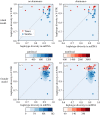Sex-linked genetic diversity originates from persistent sociocultural processes at microgeographic scales
- PMID: 31598251
- PMCID: PMC6731738
- DOI: 10.1098/rsos.190733
Sex-linked genetic diversity originates from persistent sociocultural processes at microgeographic scales
Abstract
Population genetics has been successful at identifying the relationships between human groups and their interconnected histories. However, the link between genetic demography inferred at large scales and the individual human behaviours that ultimately generate that demography is not always clear. While anthropological and historical context are routinely presented as adjuncts in population genetic studies to help describe the past, determining how underlying patterns of human sociocultural behaviour impact genetics still remains challenging. Here, we analyse patterns of genetic variation in village-scale samples from two islands in eastern Indonesia, patrilocal Sumba and a matrilocal region of Timor. Adopting a 'process modelling' approach, we iteratively explore combinations of structurally different models as a thinking tool. We find interconnected socio-genetic interactions involving sex-biased migration, lineage-focused founder effects, and on Sumba, heritable social dominance. Strikingly, founder ideology, a cultural model derived from anthropological and archaeological studies at larger regional scales, has both its origins and impact at the scale of villages. Process modelling lets us explore these complex interactions, first by circumventing the complexity of formal inference when studying large datasets with many interacting parts, and then by explicitly testing complex anthropological hypotheses about sociocultural behaviour from a more familiar population genetic standpoint.
Keywords: Pacific prehistory; dominance; migration; process models.
© 2019 The Authors.
Conflict of interest statement
We declare we have no competing interests.
Figures







References
-
- Downey SS, Hallmark B, Cox MP, Norquest P, Lansing JS. 2008. Computational feature-sensitive reconstruction of language relationships: developing the ALINE distance for comparative historical linguistic reconstruction. J. Quant. Ling. 15, 340–369. (10.1080/09296170802326681) - DOI
LinkOut - more resources
Full Text Sources
Miscellaneous
